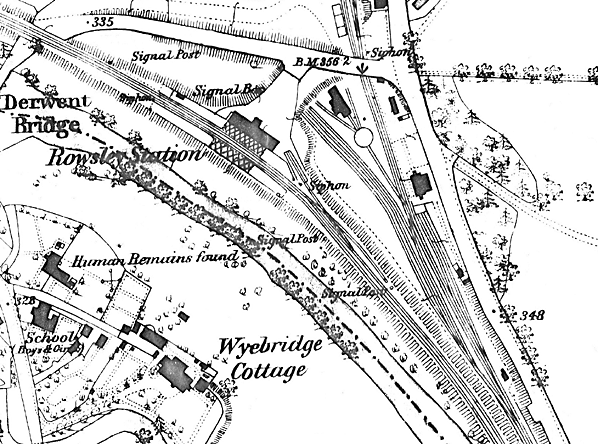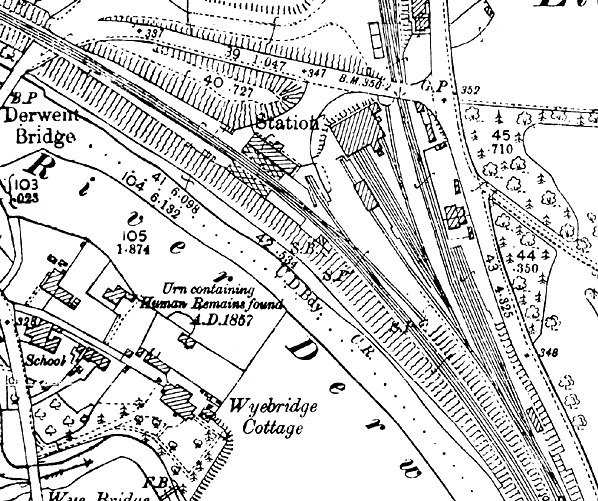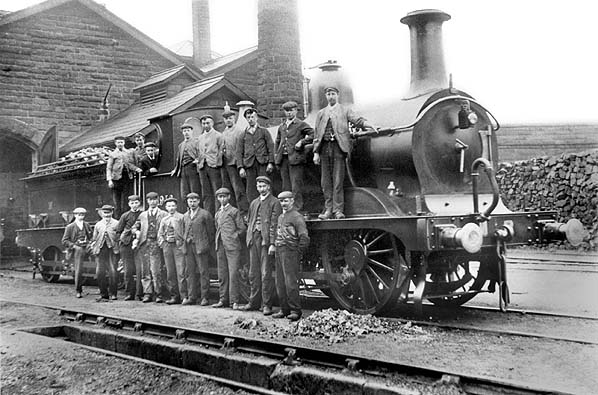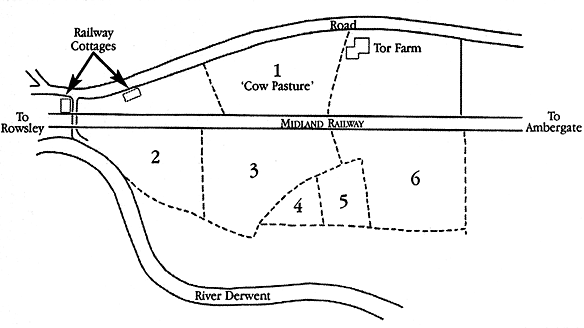Notes: When the Manchester, Buxton, Matlock and Midland Junction Railway (MBM&MJR) opened its line from Ambergate to Rowsley on the on the 4th June 1849 a locomotive shed was opened a short distance to the south of the Rowsley Station.
Situated on the west side of the line just to the south of a road overbridge which carried what became the A6 over the line, the shed was a single road stone built building which had a turntable at its entrance. The shed provided space for only one engine but it did have three lines on which locomotives could be stabled. The line was worked from the onset by the Midland Railway (MR). The operation of both passenger and goods services was shared by the ‘Rowsley engine’ and one based at Derby. The shed at Rowsley proved quite adequate for a period but in 1860, the Midland Railway projected a new line to Buxton from a point south of the shed and terminus. The first part opened to Hassop on 1st August 1862. The Rowsley engine was still used to operate these services, but when the line was extended to Buxton on 1st June of the following year, it is believed that it closed – for a short period, at least. The Rowsley engine driver, Francis Emmerson, is said to have driven the first train into Buxton before subsequently taking up residence in that town, while John Bell, the Rowsley guard, became the first Station Master at Longstone.
However, the need to assist trains up the 15 mile bank from Rowsley to Buxton and, from October 1866, to Peak Forest, found new use for the engine shed. At the beginning of 1869, the Midland’s Locomotive Committee reported that a new shed was required for two engines, but other than a minor extension no action was taken. A site visit in February 1873 reported that the present shed was ‘totally inadequate’ and on the need for new one on adjacent land.
In the early 1870s sidings were laid out to the south of the shed which were used for the sorting of goods trains. On the 4th March 1873 the MR ordered that tenders be obtained for the construction of a wooden hut adjacent to the sidings that could be used by railway staff employed to work at the sidings. Two months later the MR set about acquiring additional land that could be used for even more sidings. On the 3rd March 1874 an estimate for £998 was submitted for the construction of the sidings. Twelve months later the MR obtained a further quote for yet more sidings. This time the price was £27,944 and demonstrates how rapidly the facilities at Rowsley were expanding. Work began in 1875 on the 19th March 1877 the largest area of sidings up to that point opened at Rowsley.
The need for the assisting engines, the large area of sorting sidings and the ever increasing traffic led to the MR rebuilding the Locomotive Shed at Rowsley. The contract was let on 5th February 1878 work was started almost immediately and completed in 1879. The enlarged was a stone built four track straight dead ended shed with a triple gable style pitched slate roof. The new shed building made use of the engine pit from the previous building under one of its gables. The other two gables unusually coverd one and then two tracks situated to the west of the original building. It is believed that the two track gable was originally intended as a carriage shed.
Outside of the building facilities were also improved. The turntable was re-sited and a ramped coal stage was constructed to the west of the engine shed adjacent to the Buxton line. A boiler house and sand furnace were contained within the shed. In 1882 a new turntable was built in the sidings to the south and in 1887 a well was sunk and a water tower was provided.
As traffic expanded in the Sidings, this shed also became inadequate. To partly solve the problem many of the trains to and from Rowsley were worked by engines and men based at other depots.
Nevertheless, the lack of adequate accommodation and the associated congestion continued to cause concern and on 21st July 1898 the Midland Railway’s Way & Works Committee recommended that 7 acres, 1 rood and 29 perches of land on the Up (Matlock direction) side near Rowsley South Junction, known as ‘Cow Pasture’, be purchased from the Stancliffe Estates for £1,500 and a new shed be built on the site. The conveyance was signed on 27th December.
When the Midland’s General Purposes Act was passed the following year, it included powers to retrospectively acquire this plot of land, but also five further plots on the opposite side of the line.
In the summer of 1900 the Way & Works Committee accepted an estimate of £28,938 for the construction of a new shed which could accommodate 24 locomotives and later recommended that plots 2 and 3 identified in the 1899 General Purposes Act be purchased from the Trustees of the Whitworth Estates for £1,500. This was eventually completed in July 1902; five months earlier, plots 4, 5 and 6 had been purchased from John Gooddie Holmes for £2,200.
Around the same time, the Midland’s Locomotive Committee had reported that ‘the want of engine stabling was being seriously felt’ and ordered that a further estimate be obtained for a new engine shed. This turned out to be a less ambitious scheme than the one in 1900, the estimated cost being £22,030 for accommodating 16 engines rather than 24.
The signs, therefore, were that something imminent was about to take place, but for some unknown reason, though possibly a financial one, nothing happened. The Midland at this time had already committed huge sums on the building of a new direct route from New Mills to Heaton Mersey to improve journey times to Manchester, and on the Midland Hotel in that city.
It was 1914 before the matter again received serious attention. A further estimate for the construction of a new engine shed was requested, and on 14th May the Way & Works Committee accepted one of £21,430, which was to be mainly built on land purchased from the Whitworth Estates in 1902 (plots 2 and 3).
Although war was declared soon afterward, with the Government assuming control of the main line railway companies through a Railway Executive, this did not affect initial preparations. The High Peak News for 27th February 1915 reported that the Midland Railway was actively engaged in developing its new ‘railway centre’, while the Railway News for 15th May stated that the Directors of the company were ‘prepared to receive tenders for the erection of an engine shed for twenty-four engines at Rowsley’. Specifications could be obtained from the Engineer’s Office at Derby, with tenders delivered to the secretary of the Way & Works Committee by 19th May.
All a bit rushed it would appear, but quite a lot of preparatory work had taken place in recent months. The High Peak News for 5th June reported that ‘the railway extension by Meadow Cottages is progressing very satisfactorily and a new large signal box is already complete’. It did say, however, that it would be some time before the shed could be erected.
The existing signal box at Rowsley South Junction was located on the Down side of the line and, therefore, had to be removed so that the connection to the shed site, adjacent turntable and engineer’s sidings, could be laid. The new signal box, which was built directly opposite the old one on the Up side, was brought into use a few days later on 20th June. The weekly signalling notice also advised that ‘a new connection between the new engine shed and turntable sidings and shunting siding alongside the Down main line will be brought into use’.
On 22nd January 1916, the High Peak News reported that the tender for the stonework for the new engine shed had been let and would come from Whatstandwell. It also said that men were engaged in constructing the engine turntable and laying sidings, some of which had been brought into use.
All this was in complete contrast to the report in the newspaper a couple of weeks later on 5th February, which said that it was understood that the scheme for the erection of the engine shed had now been postponed until after the war, but ‘meanwhile, the new turntable is finished off’.
And so the scheme was put in abeyance once again. Neither was it resurrected immediately after hostilities ceased, for inflation, which was virtually unheard of before the war, continued to rise and did not reach its peak – at 169% of pre-war levels – until January 1921. There was also the proposed grouping of the railway to occupy the minds of the Midland Railway’s directors. Nevertheless, the need for a new engine shed remained critical and, two decades after purchasing the land, the contract for its construction was finally let to E. Wood & Sons on 14th December 1922 – just a couple of weeks before the Midland became a constituent of the London Midland & Scottish Railway.
Although this was to be quite a substantial structure, with accommodation for 24 locomotives inside, the contract was only for £22,205.11s.8d, marginally more than the estimate in 1914 and less than the original one in 1900. Bearing in mind wartime inflation, this represented a saving of around 50%. Perhaps one of the main differences, however, was that this shed was to be built with bricks rather than stone, which was the intention with the earlier schemes.
Even then, things did not go exactly to plan. Photographs and correspondence indicate that the shed building had been completed by the end of 1924, yet it was not until 28th June 1926 that was brought into use. Even then, the coaling plant was not ready and engines had to be coaled at the old shed until October. This no doubt provides part of the answer, but the financial state of the LMS, a period of depression, and various strikes will have played a part.
No doubt the opening would have taken place a little earlier had it not been for the General Strike in May 1926. The consequence of this resulted in the first few months after the opening being somewhat surreal. At the end of May, the LMS suspended the guaranteed week for railwaymen and many of the younger hands in particular were put on short time, initially on a 3 day per week basis rather than the 6 day working week that then existed. It would be mid September before operations were ‘back to normal’.
By the end of 1926 the new Shed was fully operational and Rowsley’s first locomotive shed which had stood on the same site since 1849 closed. The site of the old shed was reported as in a dilapidated condition at the end of 1934 and the Chief Operating Manager recommended that it be cleared, other than four sidings which were to remain for the storage of loco coal for Buxton and Rowsley Sheds. On 22nd July 1935 the Express Dairy Company leased the site for the installation of a spray pond condenser.
Source – Rowsley Old Station and Goods Yard by Glyn Waite (The Rowsley Association), Published by Pynot Publishing. Rowsley’s Engine Sheds by Glynn Waite (Rowsley Association), 2007. Both available from the Rowsley Association. Through Limestone Hills by Bill Hudson. Published by OPC 1989 ISBN 978-0860932178
Click here for Rowsley 2nd Locomotive depot
Click here for Rowsley sidings
Click here to see a series of pictures of the A6 bridge at the north end of Rowsley station being replaced in 1965.
To see other stations between Manchester Central & Matlock click on the station name:Manchester Central, Chorlton-cum-Hardy, Withington & West Didsbury, Didsbury, Heaton Mersey, Cheadle Heath, Hazel Grove (Midland), Buxworth, Chinley (2nd site) STILLOPEN, Chinley (1st site), Chapel-en-le-Frith Central, Peak Forest, Cheedale Halt, Buxton (Midland), Blackwell Mill Halt, Millers Dale, Monsal Dale, Great Longstone, Hassop, Bakewell, Rowsley (1st site), Rowsley South PEAK RAIL, Darley Dale, Matlock Riverside PEAK RAIL & Matlock STILL OPEN. See also Stockport Tiviot Dale & Stockport Portwood |

old8.jpg)



shed_old34.jpg)
shed_old35.jpg)
second_old49.jpg)
second36.jpg)

shed_old_thumb33.jpg)

shed_old_thumb30.jpg)



 Home Page
Home Page